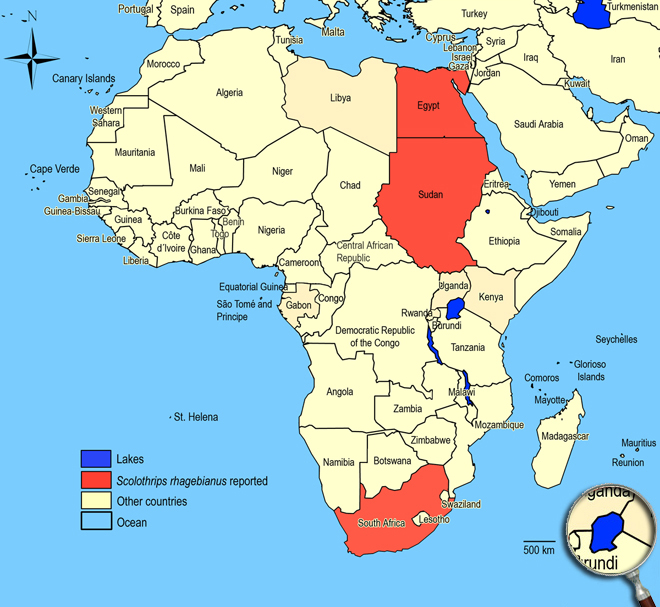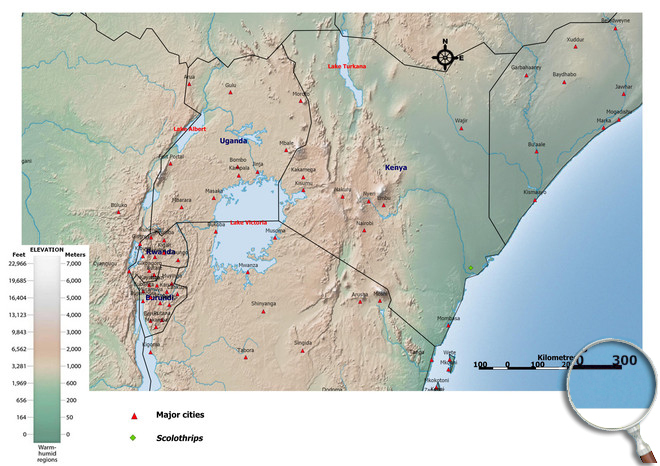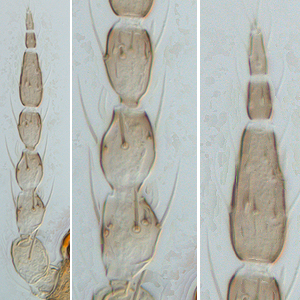Scolothrips rhagebianus Priesner, 1950
Thripinae, Thripidae, Terebrantia, Thysanoptera
Figures
Fig. 1: 8-segmented antenna, segments III-V, terminal segments VI-VIII
Fig. 2: Head dorsal with ocellar triangle
Fig. 3: Pronotum
Fig. 4: Meso- and metanotum
Fig. 5: Fore wing, basal and distal region of fore wing
Fig. 6: Tergites III-V
Introduction and recognition
Scolothrips rhagebianus is a predator of Tetranychid mites and thrips. They are associated with many different plants, particularly cotton, Cucurbita sp., Solanum sp. Body color yellow with grey brown markings laterally on pronotum, also metascutellum and at least tergites III-VI medially grey brown; all femora with an irregular grey spot, fore and middle tibia with a grey ring beyond base; antennal segments I & II pale, III & IV shaded with grey, V-VIII greyish; fore wings pale with 2 small dark transverse bands, basal half of clavus also dark. Antennae 8-segmented; segments III & IV with long forked sense cone (Fig. 1). Head wider than long; without sculpture between ocelli; 3 pairs of ocellar setae present, pair III very long and arising on anterior margins of ocellar triangle; postocular setae small (Fig. 2). Pronotum with 6 pairs of very long setae (1 pair anteroangularly, 1 pair anteromarginally, 1 pair laterally, 2 pairs posteroangularly, and 1 pair posteromarginally) (Fig. 3). Meso- and metafurca with spinula. Metanotum with transverse reticulate sculpture, weakly at anterior; median setae longer than lateral setae and arising at anterior margin; campaniform sensilla absent (Fig. 4). Mid and hind tarsi 2-segmented. Fore wing costal setae about twice as long as median wing width; first and second veins each with an incomplete row of about 6-9 long setae; clavus with 3 veinal setae (Fig. 5). Tergites with no sculpture medially (Fig. 6); VIII without posteromarginal comb; X with no median longitudinal split. Sternites without discal setae; median setae on sternite VII arising in front of posterior margin.
Male unknown.
Taxonomic identity
Species
Scolothrips rhagebianus Priesner, 1950
Taxonomic history
Scolothrips indicus Priesner, 1950
Common name
-
Present taxonomic position
Family: Thripidae Stephens, 1829
Subfamily: Thripinae (Stephens) Karny, 1921
Genus: Scolothrips Hinds, 1903
Genus description
The genus Scolothrips Hinds, 1903
There are about 15 species listed in this genus, originally from the Old World. All species are known to be predators of spider mites (Mound & Kibby 1998). Members of the genus are easily distinguished from other Thripidae by the presence of 6 pairs of very long setae on the pronotum (Mound & Marullo 1996). Furthermore setae on head and fore wing also long and conspicuous. Priesner (1950) studied taxonomic relationships of this genus and provided a key to the known Scolothrips species in the middle of the last century, and zur Strassen (2003) a key to 6 species of Europe including Canarian Islands.
Species description
Typical key character states of Scolothrips rhagebianus
Coloration and body sculpture
Body color: mainly pale to yellow, or with some darker markings
Surface of head, pronotum and fore legs: without obvious or with weakly reticulate sculpture
Antennae
Form of sense cones on antennal segments III and IV: emergent and forked on segments III and IV
Number of antennal segments: 8
Antennal segment I: without any setae on dorsal apical margin
Antennal segment II: without an exceptionally long seta at the inner apex
Antennal segment II shape: symmetric
Antennal segment III shape: symmetric
Length of antennal segment III and IV: antennal segment III similar in length to segment IV
Antennal segment IV and V: without a hyaline ring near the base
Forked sense cone on antennal segment IV: extending to a point at least a third to base of segment V
Antennal segment VI bears: not a remarkably dagger-shaped sensorium
Head
Distance between bases of ocellar setae III: greater than width of first ocellus
Head: not prolonged in front of compound eyes
Ocellar setae I: present
Ocellar setae III: arising on anterior margin of, or in front of ocellar triangle
Ocelli: present
Length of postocular setae: not alternating short and long setae
Number of ocellar setae: 3
Prothorax
Number of pairs of long anteroangular setae: 1
Number of pairs of long posteroangular setae: 2
Number of pairs of elongate pronotal setae: 6
Pronotal blotch or internal apodeme: absent
Pronotum shape: broadly rectangular
Pronotum posteromarginal/posteroangular setae: S2 longer than S3, not equal in length
Mesothorax
Mesosternal furca: with median spinula
Metathorax
Metanotal campaniform sensilla: absent
Metanotal median setae: S1 at anterior margin
Metanotum with dominant sculptured triangle medially: absent
Metasternal furca: with spinula
Shape of metathoracic furca: transverse, V-shaped
Metanotal median setae length: longer than lateral metanotal setae
Wings
Fore and hind wings: present, more than half as long as abdomen (macropterous)
Fringe cilia arising: from sockets
Fore wing veins: present
Fore- and hind wing surface: covered with microtrichia
Apex of fore wing: with prominent terminal setae
Fore wing anterior margin (costal vein): with setae and cilia but setae longer than cilia
Fore wing costal fringe cilia: arising at anterior margin of wing
Fore wing first vein: distinct from costal vein
Fore wing first vein setal row: incomplete, with setae not closely and uniformly spaced
Fore wing second vein setal row: incomplete, with setae not closely and uniformly spaced
Fore wing shape: mainly parallel sided or margins run continuously towards each other
Fore wing surface: not reticulate
Fringe cilia on posterior margin near apex: distinctly wavy (undulated)
Length of fore wing costal setae at middle of wing: about twice or more as long as median wing width
Shape of fore wing apex: with mainly posterior margin curved to join anterior margin
Fore wing extreme apex color: pale
Fore wings: alternating bands of dark and light
Legs
Fore tibia: not prolonged around fore tarsus
Mid and hind tarsi: with two segments
Color of fore tarsi: pale or yellow, sometimes apical shaded or brown
Abdomen
Pleurotergites: not covered in microtrichia
Sternite II: with marginal setae but no discal setae
Sternites IV, V and VI: with marginal setae but no discal setae
Sternite VII median posteromarginal setae S1: arising in front of posterior margin
Sternite VII: with marginal setae but no discal setae
Surface of lateral thirds of abdominal tergites: without regular rows of fine microtrichia
Tergites II to VII median setal pair: no more than 0.3 as long as median length of tergite
Tergites IV and V median setal pair: shorter than distance between their bases
Tergites V to VII: without ctenidia laterally, but sometimes with rows of microtrichia
Craspedum on tergites IV to VI: absent
Craspedum on tergite VIII: without craspedum medially and toothlike microtrichia laterally
Tergite VIII ctenidia: without paired ctenidia laterally, sometimes with irregular microtrichia
Tergite VIII posteromarginal comb of microtrichia: absent
Tergite X: not tubular, longitudinally incomplete
Setae on abdominal tergite X: all setae slender

Similar or related species
Scolothrips rhagebianus can be distinguished from other species by the 6 pairs of long setae on the pronotum, and the costal setae which are longer than costal cilia and about twice as long as median wing width. These chaetotaxy of Scolothrips species appears to be unique amongst all adult Thripidae.
Biology
Life history
As with other thrips species the life cycle from egg to adult is dependent on temperature. The full cycle can take about 15 days (Lewis 1973) to over a month and adults may live for more than one month producing several generations in one year depending on seasonal weather.
Host plants
Collected from many different plants, particularly cotton, Cucurbita sp., Hibiscus esculentus, Solanum sp.
Vector capacity
None identified, but possible mechanical distribution of phytopathogenic fungi and bacteria.
Damage and symptoms
-
Detection and control strategies
-
Additional notes
Predatory on leaf-feeding mites like Tetranychids and Tenupalpids, and commonly taken on legume crops (Xu et al., 2007; Pakyari et al. 2009; Pakyari, 2011; Mound, 2011; Pakyari et al 2012). The pronotal chaetotaxy of Scolothrips species appears to be unique amongst adult Thripidae, but it is interesting to note that a similar arrangement of long setae is found on the pupae of Thrips tabaci.
Biogeography
India, Africa.
Egypt (Beni Suef; Malaka; Wadi Halfa),
South Africa,
Sudan.
African countries where Scolothrips rhagebianus has been reported

Occurence of Scolothrips rhagebianus in East Africa

Please click here for survey sites of all observed thrips species of Kenya, Tanzania and Uganda.
Click here for locations of Scolothrips rhagebianus in parts of East Africa.

Bibliography
Ananthakrishnan TN (1969). Indian Thysanoptera. Council for Scientific and Industrial Research, Zoological Monograph, No. 1. Publications and Informative Directorate CSIR, New Delhi, 171 pp
Bournier J-P (2002). Les thysanoptères du cotonnier. Les déprédateurs du cotonnier en Afrique tropicale et dans le reste du monde, No. 12. CIRAD-CA, Montpellier, 104 pp
Lewis T (1973). Thrips: Their biology, ecology and economic importance. Academic Press Inc., London Ltd., 349 pp
Lewis T (1997). Thrips as crop pests. CAB International, Wallingford, 740 pp
Moritz G (2006). Thripse. Pflanzensaftsaugende Insekten, Bd. 1, (1. Auflage). Westarp, Hohenwarsleben, 384 pp. ISBN-13: 978 3 89432 891 7
Moritz G, Morris DC & Mound LA (2001). ThripsID - Pest thrips of the world. ACIAR and CSIRO Publishing Collingwood, Victoria, Australia, CDROM ISBN 1 86320 296 X
Moritz G, Mound LA, Morris DC & Goldarazena A (2004). Pest thrips of the world - an identification and information system using molecular and microscopical methods. Centre for Biological Information Technology, University of Queensland, Australia, CDROM ISBN 1 86499 781 8
Mound LA (2011). Species recognition in the genus Scolothrips (Thysanoptera, Thripidae), predators of leaf-feeding mites. Zootaxa 2797: 45-53
Mound LA & Kibby G (1998). Thysanoptera: An identification guide, (2nd edition). CAB International, Wallingford and New York, 70 pp
Mound LA & Marullo R (1996). The thrips of Central and South America: An introduction (Insecta: Thysanoptera). Memoirs on Entomology, International, Vol. 6. Associated Publishers, Gainsville, 487 pp
Pakyari H, Fathipour Y, Rezapanah M, Kamali K (2009). Temperature-dependent functional response of Scolothrips longicornis (Thysanoptera: Thripidae) preying on Tetranychus urticae. Journal of Asia-Pacific Entomology 12: 23-26
Pakyari H (2011). Development rate of Scolothrips longicornis (Thysanoptera: Thripidae) at various temperature. Academic Journal of Entomology 4 (1): 1-6
Pakyari H, Maafi MA, Kim DS, Enkegaard A (2012). Oviposition model of Scolothrips longicornis fed on Two-spotted Spider mite. Academic Journal of Entomology 5 (2): 65 - 72
Priesner H (1950). Studies on the genus Scolothrips (Thysanoptera). Bulletin de la Société Fouad 1er ďEntomologie. 34: 39-68
Xu LD, Juan T, Rui SZ (2007). Functional response of the predator Scolothrips takahashii to hawthorn spider mite, Tetranychus viennensis effect of age and temperature Biocontrol 52 (1): 41-61
zur Strassen R (1960). Catalogue of the known species of South African Thysanoptera. Journal of the Entomological Society of Southern Africa. 23 (2): 321-367
zur Strassen R (2003). Die terebranten Thysanopteren Europas und des Mittelmeer-Gebietes. Die Tierwelt Deutschlands und der angrenzenden Meeresteile nach ihren Merkmalen und nach ihrer Lebensweise, 74. Teil. Goecke & Evers, Keltern, Germany, 277 pp
----
Web links
Mound´s Thysanoptera pages
Thysanoptera Checklist
ICIPE Thrips survey sites
UNI Halle & Thrips sites
Thrips of California










